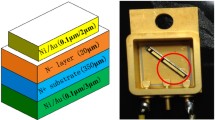Abstract
Boron carbide diode detectors, fabricated from two different polytypes of semiconducting boron carbide, will detect neutrons in reasonable agreement with theoretical expectations. The performance of the all boron carbide neutron detector differs, as expected, from devices where a boron rich neutron capture layer is distinct from the diode charge collection region (i.e. a conversion layer solid state detector).
Diodes were fabricated from natural abundance boron (20% 10B and 80% 11B.) directly on the metal substrates and metal contacts applied to the films as grown. The total boron depth was on the order of 2 microns. This is clearly not a conversion-layer configuration. The diodes were exposed to thermal neutrons generated from a paraffin moderated plutonium-beryllium source in moderated and unmoderated, as well as shielded and unshielded experimental configurations, where the expected energy peaks at at 2.31 MeV and 2.8 MeV were clearly observed, albeit with some incomplete charge collection typical of thinner diode structures. The results are compared with other boron based thin film detectors and literature models.
Similar content being viewed by others
References
B.W. Robertson, S. Adenwalla, A. Harken, P. Welsch, J.I. Brand, P.A. Dowben, and J.P. Claassen, Applied Physics Letters 80, 3644–3646 (2002)
B.W. Robertson, S. Adenwalla, A. Harken, P. Welsch, J.I. Brand, J.P. Claassen, N.M. Boag, and P.A. Dowben, Advances in Neutron Scattering Instrumentation, I.S. Anderson, B. Guérard, Eds. Proc. SPIE Vol. 4785, 226–233 (2002)
S. Adenwalla, R. Billa, J.I. Brand, E. Day, M.J. Diaz, A. Harken, A. McMullen-Gunn, R. Padmanabhan and B.W. Robertson, Penetrating Radiation Systems and Applications V, Proc. SPIE 5199, 70–74 (2003)
A.N. Caruso, R.B. Billa, S. Balaz, J.I. Brand and P.A. Dowben, J. Physics Condensed Matter 16, L139–L146 (2004)
A.D. Harken, E.E. Day, B.W. Robertson, S. Adenwalla, Jap. J. Appl. Phys. 44, 444–445 (2005)
E. Day, M.J. Diaz, S. Adenwalla, “Effect of bias on neutron detection in thin semiconducting boron carbide films”, Applied Physics Letters, submitted
D. Emin and T.L. Aselage, J. Appl. Phys. 97, 013529 (2005)
D.N. McIlroy, J. Physics-Condensed Matter 16, V13–V14 (2004)
Z.W. Bell, D.A. Carpenter, S.S. Cristy, V.E. Lamberti, A. Burger, B.F. Woodfield, T. Niedermayr, I.D. Hau, S.E. Labov, S. Friedrich, W.G. West, K.R. Pohl, L. van der Berg, Phys. Stat. Solidi c2, 11592–1605 (2005)
A. Owens, A. Peacock, Nucl. Intrumen. Methods Phys. Res. A 531, 18–37 (2004)
P.M. Martin, Vacuum Coating and Technology, 6–11 (2004)
D.S. McGregor, J.K. Shultis, Nucl. Instrum. Methods Phys. Res. A 517, 180 (2004)
D.S. McGregor, J.K. Shultis, Nucl. Instrum. Methods Phys. Res. A 536, 232 (2005)
N. Sato, O. Ishiwata, Y. Seki, and A. Ueda, Jpn. J. Appl. Phys. 29, 2526 (1990).
D.S. McGregor, S.M. Vernon, H.K. Gersch, S.M. Markham, S.J. Wojtczuk, and D.K. Wehe, IEEE Trans. Nucl. Sci. 47, 1364 (2000).
C.A. Baker, K. Green, M.G.D. van der Grinten, P.S. Iaydjiev, S.N. Ivanov, S. Al-Ayoubi, P.G Harris, J.M. Pendlebury, D.B. Shiers, and P. Geltenbort, Nucl. Instrum. Methods A 487, 511 (2002).
A. Rose, Nucl. Instrum. Methods 52, 166 (1967)
A.D. Harken, C.N. Lundstedt, E.E. Day and B.W. Robertson, “Neutron Detection Efficiency and Capture Product Energy Spectra of All-Semiconducting-Boron Carbide and Conversion-Layer Detectors”, IEEE Transactions on Nuclear Science, Volume 7, 16–22 Oct. 2004 Page(s): 4585 – 4589
C. Lundstedt, A. Harken, E. Day, B.W. Robertson, and S. Adenwalla, “Modeling Solid-State Boron Carbide Low Energy Neutron Detectors”, Nucl. Instrum. and Methods in Phys. Res. A 562 (2006) 380
S.-D. Hwang, D. Byun, N.J. Ianno, P.A. Dowben, H.R. Kim, Appl. Phys. Lett. 68, 1495–1497 (1996)
S. Adenwalla, P. Welsch, A. Harken, J.I. Brand, A. Sezer, B.W. Robertson, Appl. Phys. Lett. 79, 4357–4359 (2001)
S.-D. Hwang, K. Yang, P.A. Dowben, A.A. Ahmad, N.J. Ianno, J.Z. Li, J.Y. Lin, H.X. Jiang, D.N. McIlroy, Appl. Phys. Lett. 70, 1028–1030 (1997)
A.N. Caruso, P.A. Dowben, S. Balkir, N. Schemm, K. Osberg, R.W. Fairchild, O.B. Flores, S. Balaz, A.D. Harken, B.W. Robertson, J.I. Brand, Material Science and Engineering B 135 (2006) 129–133
Author information
Authors and Affiliations
Rights and permissions
About this article
Cite this article
Sabirianov, I.F., Fairchild, R.W. & Brand, J.I. The All Boron Carbide Diode Neutron Detector: Experiment and Modeling Approach. MRS Online Proceedings Library 981, 606 (2006). https://doi.org/10.1557/PROC-981-0981-JJ06-06
Received:
Accepted:
Published:
DOI: https://doi.org/10.1557/PROC-981-0981-JJ06-06




